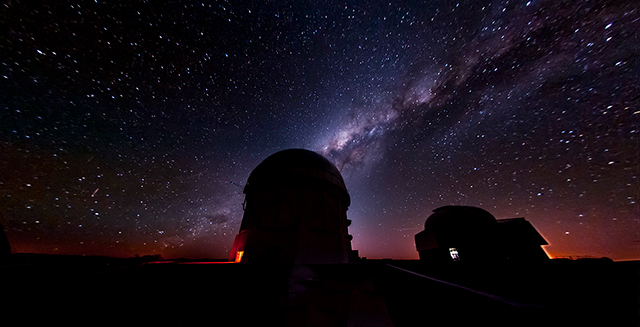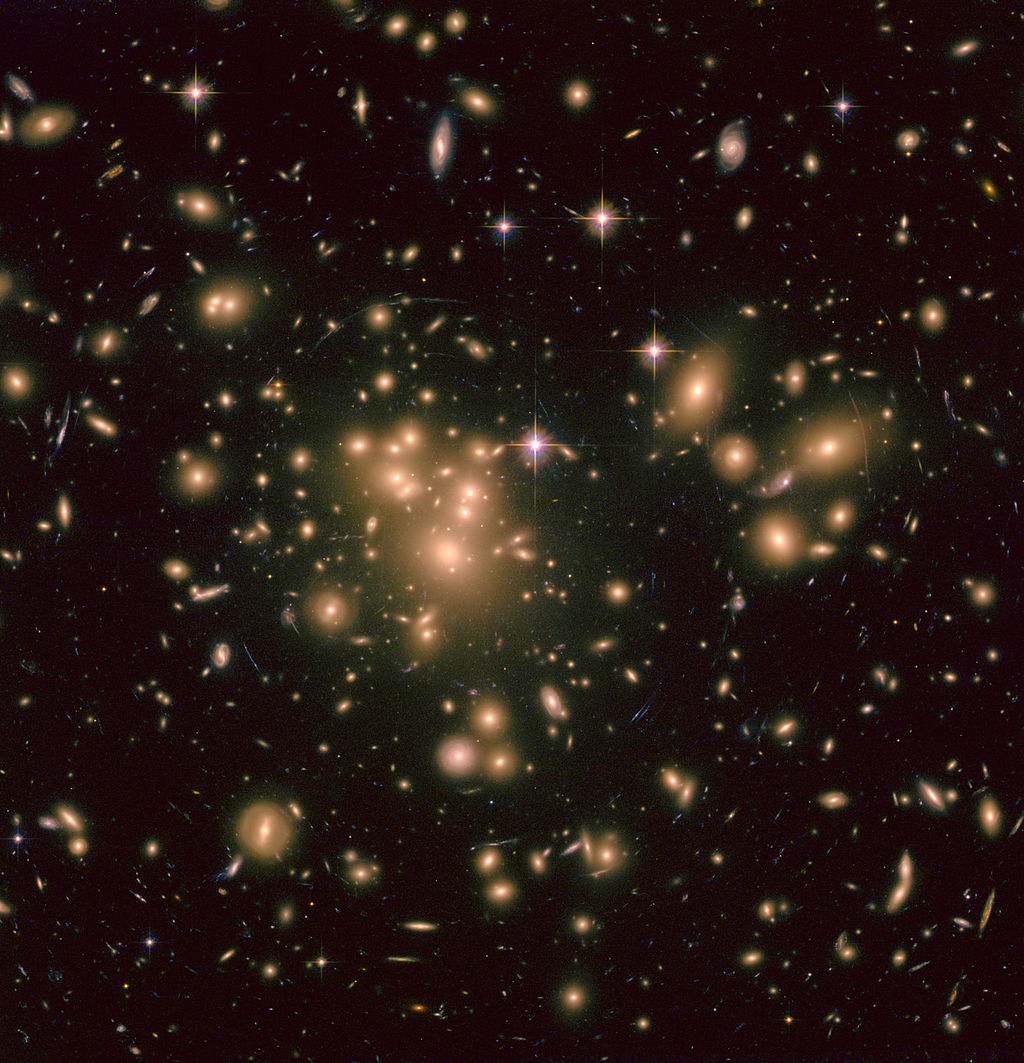Finding Dark Energy in the Details

Like most theoretical cosmologists, Joshua Frieman was thrilled when astronomers announced in 1998 that the expansion of the universe appeared to be speeding up, driven by an invisible agent that they called “dark energy.”
Frieman and his fellow theorists imagined two possible causes for the cosmic acceleration: Dark energy could be the quantum jitter of empty space, a “cosmological constant” that continues to accrue as space expands, pushing outward ever more forcefully. Alternately, a yet-undetected force field could pervade the cosmos, one akin to the field that scientists believe powered the exponential expansion of the universe during the Big Bang.
But the scientists also realized that the two options would have nearly identical observational consequences, and either theory could fit the crude measurements to date.
To distinguish between them, Frieman, a professor of astronomy and astrophysics at the University of Chicago and a senior staff scientist at the Fermi National Accelerator Laboratory (Fermilab) in nearby Batavia, Ill., co-founded the Dark Energy Survey (DES), a $50 million, 300-person experiment. The centerpiece of the project is the Dark Energy Camera, or DECam, a 570-megapixel, optical and near-infrared CCD detector built at Fermilab and installed on the four-meter Blanco Telescope in Chile two years ago. By observing 300 million galaxies spanning 10 billion light-years, DES aims to track the cosmic acceleration more precisely than ever before in hopes of favoring one hypothesis over the other. Frieman and his team are now reporting their first results.
Quanta Magazine caught up with Frieman in late August during COSMO 2014, a conference he helped organize. With his closely clipped gray beard, tortoiseshell glasses and organic cotton shirt, the scientist fit right in with the other gourmands lunching at Eataly Chicago down the street. Between bites of tagliatelle, he explained just what is and isn’t known about dark energy, and how DES will help impel theorists toward one of the two disparate descriptions of its nature. An edited and condensed version of the interview follows.
QUANTA MAGAZINE: Why did you start the Dark Energy Survey?
JOSHUA FRIEMAN: As a theorist in the 1990s working on theoretical ideas for what could be causing the universe to speed up, I came to the conclusion that we could make different models and do a lot of theoretical speculation, but that we wouldn’t know which of those paths to go down until we had much better data.
So a handful of us in Illinois started discussing possibilities for getting that data. And it just so happened that, around that time, the National Optical Astronomy Observatory announced an opportunity, saying, more or less, “If someone can build a really cool instrument for the telescope we operate in Chile, we’ll give you a bunch of telescope time.” That’s when we formed the Dark Energy Survey collaboration and came up with the design for our camera.
Isn’t it unusual for a theorist to lead a major astrophysics experiment?
It’s somewhat unusual, but the boundaries between theory and observation in cosmology are getting blurred, which I think is a healthy development. It used to be that theorists like me would work with a pen and paper, and then observers would go out and take the data and analyze it. But we now have a new model in which teams are trained to analyze and interpret large data sets, and that isn’t purely theory or purely observational work; it combines the two.
How do you picture an invisible unknown like dark energy?
One way to think about dark energy is as a fluid, in the sense that it can be described by its density and its pressure. Those two properties tell you its effects on the expansion of the universe. The more dark energy there is — that is, the greater its density — the stronger its effects are. But the thing that’s really crucial about dark energy is that unlike anything else we know about, it has negative pressure, and that’s what makes it gravitationally repulsive.
Why does negative pressure make it repulsive?
Einstein’s theory says the force of gravity is proportional to the energy density plus three times the pressure, so pressure itself actually gravitates. That’s something we’re not familiar with, because for ordinary matter, the pressure is just a tiny fraction of the density. But if something has a pressure that’s a sizable fraction of the energy density, and if that pressure is negative, then I can flip the sign of gravity. Gravity’s no longer attractive — it’s repulsive.
By far the leading candidate for dark energy is the “cosmological constant.” What’s that?
Albert Einstein introduced the cosmological constant in 1917 as an additional term in the equation of gravity. In Einstein’s theory, gravity is the curvature of space-time: You have some source of energy and pressure that curves space-time, and then other matter moves within this curved space. Einstein’s equations relate the curvature of space-time to the energy and pressure of whatever’s in space.
Einstein originally put the cosmological constant on the curvature side of the equation because he wanted to get a certain solution, which turned out to be wrong. But soon after that, the Belgian physicist Georges Lemaitre realized that the cosmological constant naturally lives with the pressures and energy densities, and that it could be interpreted as the energy density and pressure of something. Already on the energy density and pressure side of the equation was everything in the universe: dark matter, atoms, whatever. If I remove all that stuff, then the cosmological constant must be the energy density and pressure of empty space.
How could empty space possess energy and pressure?
In classical physics, empty space would have no energy or pressure. But quantum effects can create energy and pressure even if there are no real particles there. In quantum theory, you can imagine virtual particles zipping in and out of the vacuum, and those virtual particles — which are always being produced and then annihilating — have energy. So if dark energy is the cosmological constant, then it could be the energy associated with these virtual particles.
How do you measure dark energy?
There are two things we’re trying to do that can give us constraints on dark energy: One is to measure distances, which tells us the history of cosmic expansion. The second is to measure the growth of structure in the universe.

For the latter, we’re using a technique called “weak gravitational lensing,” which involves measuring, very precisely, the shapes of hundreds of millions of galaxies, and then inferring how those shapes have been distorted because the light rays from those galaxies get bent by gravity as they travel to us. This lensing effect is really tiny, so in 99 cases out of 100, you can’t tell just by looking at a galaxy if it has been lensed. So we have to tease out the signal statistically.
If we look at the shapes of galaxies that are not so far versus ones that are farther, part of the difference in the shapes will be due to the fact that the light has passed through different amounts of clumpy structure. Measuring the lensing signal will give us a measure of how the clumpiness of the universe has evolved over cosmic time, and that clumpiness is impacted by dark energy. Gravity pulls stuff in, making the universe become more and more clumpy over time, but dark energy does the opposite. It makes things push away from each other. So if we can measure how the clumpiness of the universe has changed over cosmic time, we can infer something about dark energy: how much of it there was, and what its properties were at different points in time.
DES will try to calculate the dark energy “equation of state” parameter, w. What does w represent?
The parameter w tells us the ratio of the pressure of the dark energy to its density. If dark energy is the cosmological constant, then you can show that the only w that’s consistent for empty space is the one where the pressure is exactly equal to minus the energy density. So w has a very specific value: minus one.
If dark energy isn’t the cosmological constant, what else might it be?
The simplest alternatives, and the ones that I worked on in the 1990s, are inspired by “inflation.” Before we knew that the expansion of the universe is currently speeding up, we had this idea that the universe was speeding up in the very earliest fraction of a second after the Big Bang. That idea of very early cosmic acceleration is called inflation. So the simplest thing to do was to borrow the theory that explains this other epoch of sped-up expansion, and that involves scalar fields.
A scalar field is an entity that has a value everywhere in space. As the field evolves, it can act like dark energy: If it evolves really slowly, it will have negative pressure, which will cause the universe to accelerate. The simplest models of primordial inflation say that, for some period, the universe was dominated by one of these scalar fields, and it eventually decayed and disappeared. And if that’s our best idea for what happened when the universe was speeding up almost 14 billion years ago, we should consider that maybe we have something like that going on now.
If you look at these models, they tend to predict that w, the ratio of the pressure to energy density, would be slightly different from minus one. We would like to test that idea.
Moving forward, DES will also try to determine whether w is changing with time. What will that tell us?
In almost any dark energy model that’s different from a cosmological constant, w will tend to evolve in time. For example, w could start out near minus one in the distant past, and then as the scalar field evolves faster and faster, w gets further and further away from minus one. But there are other theories where the opposite can happen. And so if we can measure not just w, but also a quantity we call wa — how fast w changes in time — then we can say, “Do we live in this kind of universe, or this kind?”
What do the data so far tell us about wa?
They’re consistent with no evolution — wa equal to zero — but the errors are so large that there’s really no meaningful information. So, one thing we want to do with DES is make enough measurements to start to really constrain wa.
If you view the currently allowed values of w0 and wa on a plane, you get an area roughly bounded by an ellipse [see graph at right]. Our expectation is that we’ll be able to shrink the area of that ellipse in the w0-versus-wa plane by a factor of three to five compared to where it’s been for the last couple of years. Right now, the data are still consistent with a cosmological constant. But the hope is that, as we start to shrink the ellipse, it may shrink around something that’s inconsistent with the cosmological constant. We can’t say whether that’ll happen, but if it did, it’d be very exciting.
Why would you prefer something like a scalar field over the cosmological constant?
Because it would reveal that there is some new physics in an area where we didn’t really expect it. And also, if w is different from minus one, we would have a hope of learning something about the physics of dark energy. Whereas if it’s just the cosmological constant, then that will be interesting, but it will be harder to get a sense of where to go next.
The first few papers from DES have appeared in the past couple of months. What results have you reported?
These results are from a period that we call “science verification,” where we carried out a mini-version of our survey soon after installing the camera on the telescope to test the quality of the data it was producing. For example, in one study we measured the masses of four galaxy clusters through their gravitational-lensing effect. In another study we used the colors of galaxies to estimate their redshifts, which effectively tells us their distances. Almost all of our results on dark energy are going to rely crucially on this color redshift technique. We wanted to convince ourselves that we could measure these redshifts precisely enough to do the dark energy measurements, and we’ve been able to demonstrate that.
What is it like operating the DES telescope in Chile?
The observatory is on a mountain, Cerro Tololo, at an elevation of about 7,000 feet. It’s very dry, so there’s not much vegetation, but I find it beautiful. The system is not completely automatic, but even a theorist like me can operate the camera. We have this computer program that says, “OK, given what we’ve observed so far, given where the moon is, given what the weather’s like now, point the telescope here for the next couple of minutes.” And so for the most part you’re just sitting in the console, checking to make sure everything is working, and watching these beautiful images of the universe come up on the screen. It’s fun.
This article was reprinted on ScientificAmerican.com.



